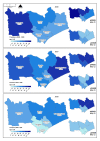The emergence of insecticide resistance in central Mozambique and potential threat to the successful indoor residual spraying malaria control programme
- PMID: 21535872
- PMCID: PMC3096596
- DOI: 10.1186/1475-2875-10-110
The emergence of insecticide resistance in central Mozambique and potential threat to the successful indoor residual spraying malaria control programme
Abstract
Background: Malaria vector control by indoor residual spraying was reinitiated in 2006 with DDT in Zambézia province, Mozambique. In 2007, these efforts were strengthened by the President's Malaria Initiative. This manuscript reports on the monitoring and evaluation of this programme as carried out by the Malaria Decision Support Project.
Methods: Mosquitoes were captured daily through a series of 114 window exit traps located at 19 sentinel sites, identified to species and analysed for sporozoites. Anopheles mosquitoes were collected resting indoors and tested for insecticide resistance following the standard WHO protocol. Annual cross sectional household parasite surveys were carried out to monitor the impact of the control programme on prevalence of Plasmodium falciparum in children aged 1 to 15 years.
Results: A total of 3,769 and 2,853 Anopheles gambiae s.l. and Anopheles funestus, respectively, were captured from window exit traps throughout the period. In 2010 resistance to the pyrethroids lambda-cyhalothrin and permethrin and the carbamate, bendiocarb was detected in An. funestus. In 2006, the sporozoite rate in An. gambiae s.s. was 4% and this reduced to 1% over 4 rounds of spraying. The sporozoite rate for An. funestus was also reduced from 2% to 0 by 2008. Of the 437 Anopheles arabiensis identified, none were infectious. Overall prevalence of P. falciparum in the sentinel sites fell from 60% to 32% between October 2006 and October 2008.
Conclusion: Both An. gambiae s.s. and An. funestus were controlled effectively with the DDT-based IRS programme in Zambézia, reducing disease transmission and burden. However, the discovery of pyrethroid resistance in the province and Mozambique's policy change away from DDT to pyrethroids for IRS threatens the gains made here.
Figures



References
-
- World Health Organization. The Fifth-Eighth World Health Assembly, 2005. 2005.
-
- Kleinschmidt I, Sharp B, Benavente LE, Schwabe C, Torrez M, Kuklinski J, Morris N, Raman J, Carter J. Reduction in infection with Plasmodium falciparum one year after the introduction of malaria control interventions on Bioko Island, Equatorial Guinea. Am J Trop Med Hyg. 2006;74:972–978. - PubMed
-
- Sharp BL, Kleinschmidt I, Streat E, Maharaj R, Barnes KI, Durrheim DN, Ridl FC, Morris N, Seocharan I, Kunene S, La Grange JJ, Mthembu JD, Maartens F, Martin CL, Barreto A. Seven years of regional malaria control collaboration--Mozambique, South Africa, and Swaziland. Am J Trop Med Hyg. 2007;76:42–47. - PMC - PubMed
Publication types
MeSH terms
Substances
Grants and funding
LinkOut - more resources
Full Text Sources
Medical
Miscellaneous

